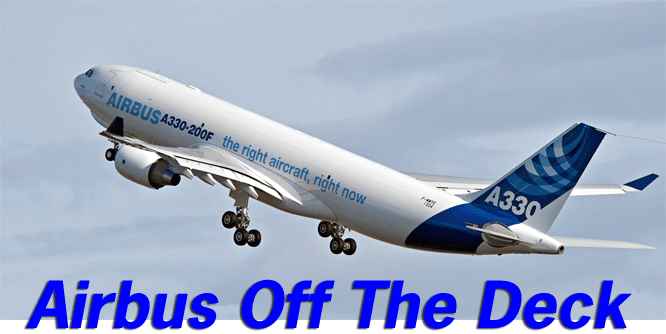
Airbus has bounced back in the
freighter biz
The last freighter produced by Airbus was handed over almost an age
ago to U.S. integrator FedEx in Summer 2007.
Since the delivery of the A300F, the European manufacturer had not
built another cargo plane.
Now a new era seems to have begun with a brand new A330-200F taking
to the skies last Thursday (November 5) for a four-hour maiden flight
over the southern parts of France.
“This milestone marks the start of a 180 hour flight-test and certification
campaign, and paves the way for first delivery of the type in the summer
of 2010,” commented Airbus in a statement.
So far nine airlines and leasing companies have placed 67 firm orders
for the craft, among them Turkish Airlines, Guggenheim Aviation and Matlin
Paterson.
The freighter can transport either 64 tons nonstop over a distance
of 7,400 km or 69 tons up to 5,930 km. The freight compartments can be
cooled down to 5 degrees centigrade enabling transports of temperature
sensitive products like perishables, pharmaceuticals or medicines. Completely
new is a software tool offered customers by Airbus that enables loadmasters
the virtual loading of the plane once they have the weights and dimensions
of the shipments.
“This will enhance the utilization of the aircraft substantially
and save the airlines money,” states Technical Program Leader Matthias
Lerovante when asked by ACN/FT.
Said Airbus Chief Operating Officer - Customers, John Leahy:
“The efficient A330-200F is very well adapted to today’s market dynamics
of rising fuel prices and increased pressure on yields.”
He adds:
“The A330-200F is the right aircraft at the right time.
“We are at the eve of a market recovery, and now is the time for
airlines to prepare for future freight growth.”
Airbus sees the need for over 3,400 freighters in the next 20 years
to cater for a 5.2% average annual growth rate. In turn, this will require
around 1,600 mid-sized freighters, of which the A330-200F will play an
important role.
Main competitor is Boeing’s B767F.
“But in comparison our freighter offers ten more tons of payload
and has an 800 nautical miles greater reach,” says Jonathan Lesieur, Marketing
Manager Freighters at Airbus.
In addition to carrying commercial goods there might be another task
coming up for the A330-200F: the replacement of the more than 45 years
old air-refueling tanker KC-135 the U.S. Air Force is still deploying.
In a joint bid submitted to the Pentagon Airbus parent European Aeronautical
Defence & Space (EADS) and their U.S. partner Northrop Grumman are eager
to win the 179 unit-comprising tanker contract valued at USD$35 billion
in its initial phase.
So is U.S. manufacturer Boeing, that appealed successfully against
the original decision by the U.S. Government in favor of the Airbus variant
in the mix. Now Boeing is back in the race with its KC-767AT (Advanced
Tanker) that is based on a newer version of the 767-200 LR long-range
freighter manufactured in Everett.
This obviously doesn’t frighten CEO Tom Enders of Airbus.
“The less costly aircraft will win that contract,” stated the manager
during a recent press gathering in Hamburg, Germany, by adding “smaller
jets are normally cheaper than bigger ones.”
In comparison to the KC-767AT the Airbus A330-200F tanker transporter
weighs less and is a smaller aircraft.
Heiner Siegmund
|



